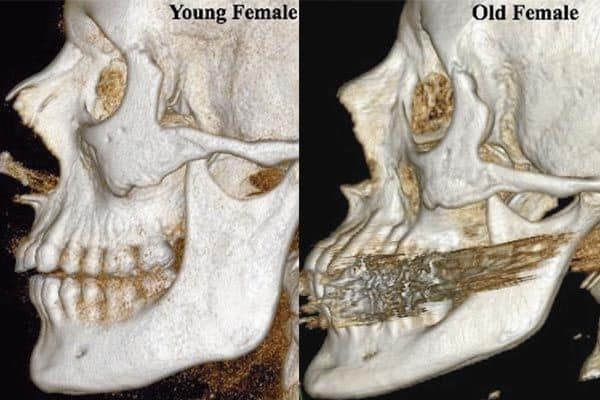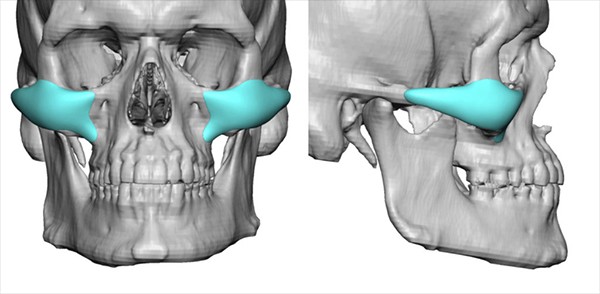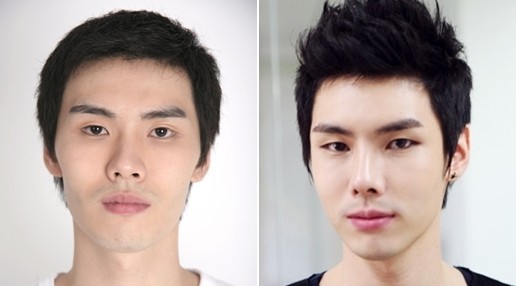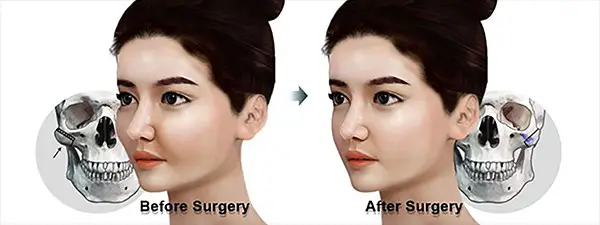
Our bones are continually remodeling (even after puberty). Prominent cheekbones are a conventionally attractive feature because they give a person a 3-dimensional and mature-looking face.
After puberty, cheekbones decrease with age due to bone loss and maxillary recession. Proper oral posture can combat the maxillary recession, but not the natural bone loss.
For more info on the importance of cheekbones and how to tell which type you have, check out our Looks Theory video:
Let’s take a look at how the cheekbones grow and shrink as you age.
How the Cheekbones Grow and Shrink
As a person reaches adulthood, their bodies develop, and their bones (including the cheekbones) grow. While most bone growth will stop after puberty, human skeletons still grow around 10% larger as they age (Garn et al., 1967).
So, does this mean that your cheekbones will continue to grow as you age?
The answer is no. There is a loss in volume in the face as people age, particularly in a person’s mid-face where the cheekbones are located(Coleman et al., 2006).
Your cheekbone may look more pronounced as you get older. However, that is often because of volume loss and fat atrophy in the face (Farkas et al., 2013).
So, when you are in your 20-30s, you may think your cheekbones grew larger. However, they might be more prominent now because of the loss of volume and fat.
Additionally, your skin becomes more transparent and thinner as you age, making your facial bones more visible.

The buccal fat pads in your cheeks also slide down and move forward. The movement and loss of your cheek fat can make your cheekbones look like they grew, but in reality, the cheekbones just became more visible.

As you can see in the above image, the cheekbone reduces in size with age.
The cheekbone may look prominent due to fat loss, thinner skin, and volume loss, but it does not “grow” with age.
How to Increase Cheekbone Size
If your goal is to increase your cheekbone size, here are three things that you can try.
- Mewing
- Dermal Fillers
- Cheek Implants
Mewing
Mewing (proper tongue posture) is exploding in popularity. The basic idea is that you keep your tongue flat on the roof of your mouth while your teeth touch. It creates a force that helps you get prominent cheekbones, a stronger jawline, and help align your teeth.
While the idea of simply changing your tongue and jaw position to alter your facial structure may seem crazy, there is plenty of supporting evidence and before/after photos behind it.

The way it works is that by keeping your tongue on the roof of your mouth 24/7, a constant force is exerted on your maxilla, which is connected to your bones. To get bones to change, strong, sharp forces won’t do it. You need forces that are high in duration, not intensity. It’s a similar concept to how a tree can grow around a fence or other object. It’s slow and can take years, but it does work.
Click here to see our full guide on mewing.

YouTube Astrosky has achieved obvious cheek hollows and high/prominent cheekbones via mewing.
Dermal Fillers
Dermal fillers are a quick way to add more volume to your cheek area. Most fillers are a gel made out of collagen or hyaluronic acid. Both materials are naturally present in your body, which is why they naturally dissolve over time. Getting dermal fillers is a quick process that usually takes around 20-60 minutes. You should see the difference in your cheeks right after the procedure is done.
Many people like getting dermal fillers because it is not permanent. You could get fillers again once they’ve dissolved or not get them again if you were not happy. If you do not like the results right after getting the fillers, a surgeon can dissolve them immediately. However, it depends on what kind you get and how your skin metabolizes the materials. For instance, some people may only see the results for six months. On the other hand, some people may see them for two years.
Fillers have many downsides though:
- It can cost hundreds if not thousands of dollars, yet require refilling constantly.
- Dermal fillers are rated to last 3-6 months, but in reality, parts of the filler can stick around for years (Victorian Cosmetic Institute).
- Potential for internal scarring and developing “plaque-like elevations” in the periorbital region (Edward et al., 2007).
- Fillers do not hold their shape well. While they are good at filling in the tear trough area, they cannot augment bones very well.
While the results in pictures always look great, this is because the picture is taken immediately after injection, and the filler hasn’t had time to migrate, flatten, and spread.
Cheek Implants
Cheek implants are an ideal option if you want to get sharp and prominent cheekbones. This is because the material is harder than the gel in dermal fillers and is suited to augment bone. Cheek implants are usually a medical-grade silicone implant that go into the desired area. Implants are customized for each patient, so they get the desired projection, and volume added to their cheekbones.

In the above example, not only are the cheekbones augmented, but so is the zygomatic arch, which is a very important feature of cheekbone aesthetics.
Cheek implants are permanent. However, you can still ask your surgeon to remove them if you do not want them anymore. You will only need to get cheek implants once if there are no complications. But if your cheekbones decrease in size after several years due to aging, you might need to get dermal fillers or new implants to retain your volume. However, you’d be better off taking mewing seriously to make sure you lose as little volume as possible with age.
Cheek implant surgery takes around 1-3 hours. The time often depends on what kind of implant you chose. The downside of cheek implant surgery is the recovery time. It can take 3-6 weeks until you fully recover from the surgery. However, if you want permanent results, the healing time may be worth it.
How to Decrease Cheekbone Size

If your goal is to decrease your cheekbone size, you can try cheekbone reduction surgery. Cheekbone reduction may sound intimidating at first. However, cheekbone reduction surgery does not flatten your cheekbone. It reshapes your cheekbones to add more dimension to your face. It can also reduce the width of your face.
There are three main techniques that most surgeons will use for cheek reduction surgeries, which are:
- L-Shaped Osteotomy
- Scalp Approach
- Malar Rotation Technique
L-Shaped Osteotomy
Your surgeon may use this technique if your cheekbones protrude to the front. It decreases the pronounced area to help you get a slimmer face.
However, it can cause droopy cheeks since there is slightly less bone. That is why most people will also get an extra surgery to correct this.
Scalp Approach
Your surgeon might use this technique if your cheekbones protrude to the sides and the front.
Your surgeon will break small pieces of your cheekbone and move them to the desired areas. It helps you get a more symmetrical face and reduces the prominence of your cheekbones.
Malar Rotation Technique
Your surgeon may use this technique if your cheekbones protrude to the sides. Your surgeon will rotate your malar bone, so it protrudes to the front.
This technique adds more dimension to your face while decreasing the width.

What You Should Know About Cheek Reduction Surgery
All three techniques usually take 1 hour to complete, but it depends on your case. You may have to stay in the hospital for at least two nights. You may have to rest for around 5-7 days to recover from the surgery. Recovery time may vary depending on the patient.
You can get your stitches removed after 7-10 days. However, you may have to wait a few more days if you have sensitive skin. You may also experience some side effects like facial bruising, swelling, and numbness. However, most of those symptoms go away after 1-2 weeks, especially if you follow post-operative care instructions.

